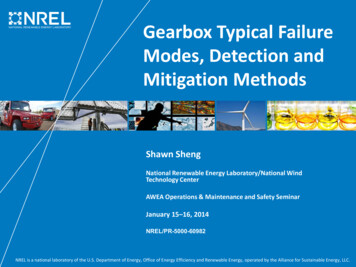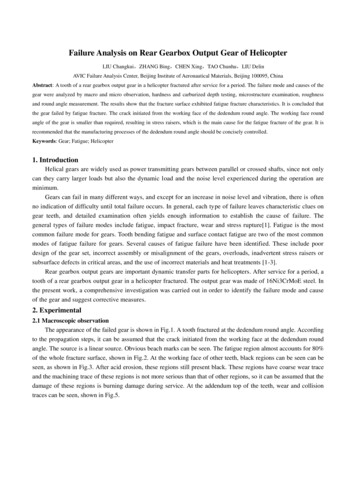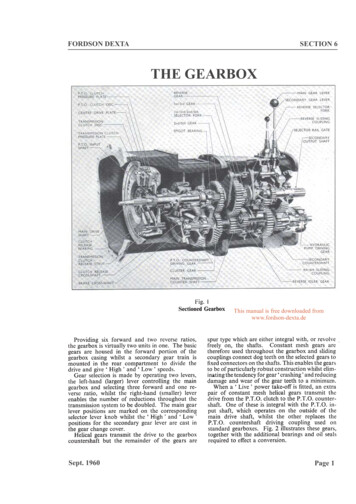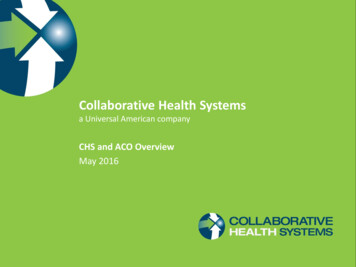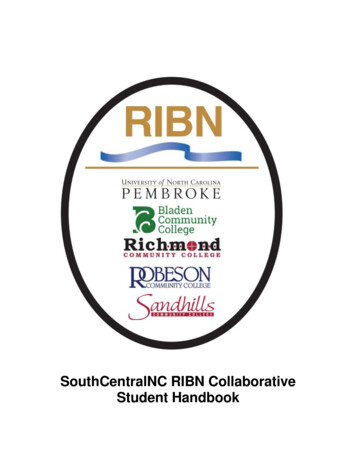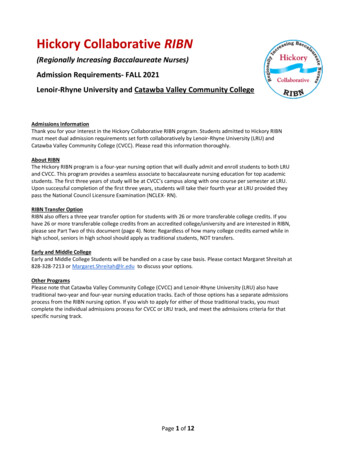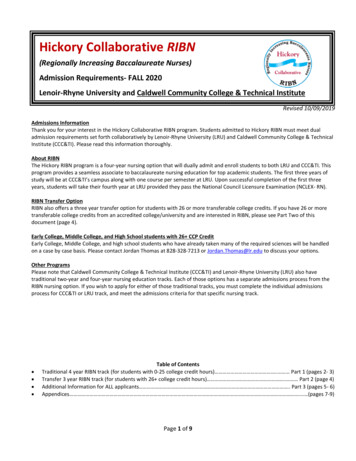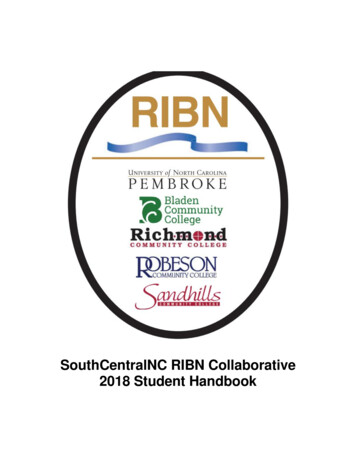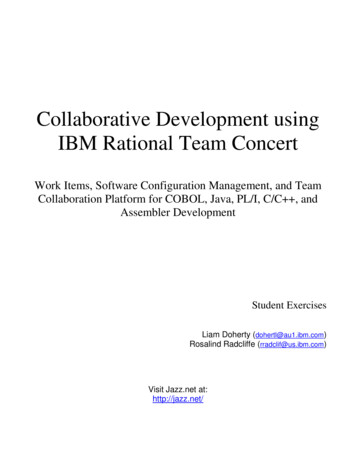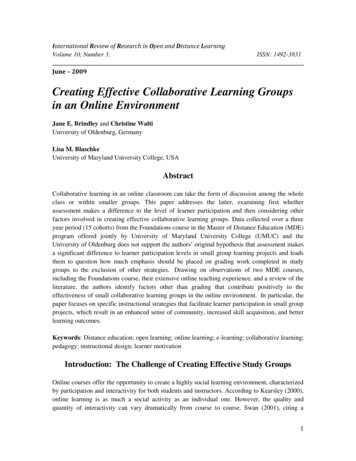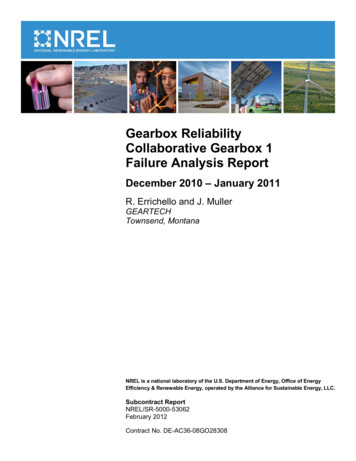
Transcription
Gearbox ReliabilityCollaborative Gearbox 1Failure Analysis ReportDecember 2010 – January 2011R. Errichello and J. MullerGEARTECHTownsend, MontanaNREL is a national laboratory of the U.S. Department of Energy, Office of EnergyEfficiency & Renewable Energy, operated by the Alliance for Sustainable Energy, LLC.Subcontract ReportNREL/SR-5000-53062February 2012Contract No. DE-AC36-08GO28308
Gearbox ReliabilityCollaborative Gearbox 1Failure Analysis ReportDecember 2010 – January 2011R. Errichello and J. MullerGEARTECHTownsend, MontanaNREL Technical Monitor: J. KellerPrepared under Subcontract No. LEE-7-77535-01NREL is a national laboratory of the U.S. Department of Energy, Office of EnergyEfficiency & Renewable Energy, operated by the Alliance for Sustainable Energy, LLC.National Renewable Energy Laboratory1617 Cole BoulevardGolden, Colorado 80401303-275-3000 www.nrel.govSubcontract ReportNREL/SR-5000-53062February 2012Contract No. DE-AC36-08GO28308
NOTICEThis report was prepared as an account of work sponsored by an agency of the United States government.Neither the United States government nor any agency thereof, nor any of their employees, makes any warranty,express or implied, or assumes any legal liability or responsibility for the accuracy, completeness, or usefulness ofany information, apparatus, product, or process disclosed, or represents that its use would not infringe privatelyowned rights. Reference herein to any specific commercial product, process, or service by trade name,trademark, manufacturer, or otherwise does not necessarily constitute or imply its endorsement, recommendation,or favoring by the United States government or any agency thereof. The views and opinions of authorsexpressed herein do not necessarily state or reflect those of the United States government or any agency thereof.Available electronically at http://www.osti.gov/bridgeAvailable for a processing fee to U.S. Department of Energyand its contractors, in paper, from:U.S. Department of EnergyOffice of Scientific and Technical InformationP.O. Box 62Oak Ridge, TN 37831-0062phone: 865.576.8401fax: 865.576.5728email: mailto:reports@adonis.osti.govAvailable for sale to the public, in paper, from:U.S. Department of CommerceNational Technical Information Service5285 Port Royal RoadSpringfield, VA 22161phone: 800.553.6847fax: 703.605.6900email: orders@ntis.fedworld.govonline ordering: http://www.ntis.gov/help/ordermethods.aspxCover Photos: (left to right) PIX 16416, PIX 17423, PIX 16560, PIX 17613, PIX 17436, PIX 17721Printed on paper containing at least 50% wastepaper, including 10% post consumer waste.
DISCLAIMERThis report may contain certain recommendations for increasing load capacity andimproving reliability of the subject gear drive. The recommendations are generalguidelines that are for the sole purpose of showing what can be achieved. They must notbe construed as specific design recommendations.The manufacturer is solelyresponsible for the design of the gear drive, and GEARTECH accepts no liability for thedesign.1
BackgroundUnintended gearbox failures have a significant impact on the cost of wind farmoperations. In 2007, NREL initiated the Gearbox Reliability Collaborative (GRC). Theproject combines analysis, field testing, dynamometer testing, condition monitoring, andthe development and population of a gearbox failure database in a multi-prongedapproach to determine why wind turbine gearboxes do not achieve their expecteddesign life. The collaborative of manufacturers, owners, researchers, and consultantsfocuses on gearbox testing and modeling and the development of a gearbox failuredatabase. Collaborative members also investigate gearbox condition monitoringtechniques. Data gained from the GRC will enable designers, developers, andmanufacturers to improve gearbox designs and testing standards and create morerobust modeling tools.GRC project essentials include the development of two identical, heavily instrumentedrepresentative gearbox designs. Knowledge gained from the field and dynamometertests conducted on these gearboxes builds an understanding of how the selected loadsand events translate into bearing and gear response. One of the gearboxes wasinstalled in a turbine at the Ponnequin wind farm and put into unattended operation onSeptember 14, 2009. The test was stopped on October 5, 2009 due to bearingtemperature exceedances and reports of oil loss from the gearbox. An inspection onOctober 6, 2009, revealed that the high-speed stage gear teeth showed signs ofsignificant overheating. It was determined that testing should be suspended to avoid thepotential for catastrophic gearbox failure. Subsequently, the gearbox was removed fromthe turbine and shipped back to NREL. After conducting a limited set of conditionmonitoring tests in the NREL dynamometer, the gearbox was sent to The Gear Worksfor disassembly and inspection [1]. The results of this disassembly and inspection arereported herein.IntroductionOn December 27-30, 2010 and January 3-7, 2011, Robert Errichello and Jane Mullerinspected one Jahnel-Kestermann (JAKE) gearbox at The Gear Works in Seattle,Washington. The root cause of the loss of oil is unknown and, therefore, not addressedin this report. In both instances, a temperature sensor on a high-speed pinion (HSP)bearing signaled a wind turbine shutdown. This report summarizes the results of theinspection of the gearbox and contains photographs of the failed components.2
NomenclatureTable 1 shows nomenclature used in this report.Table 1- NomenclatureANNAnnulus gearCARCarrierCRBCylindrical roller bearingfcCRBFull complement cylindrical roller bearingHSHigh speedHSGHigh-speed gearHSPHigh-speed pinionINTIntermediateINTGIntermediate gearINTPIntermediate pinionIRInner ringLSLow speedOROuter ringSUNSun pinionTRBTapered roller bearingNameplate dataTable 2 shows nameplate data for the gearbox.Table 2- Nameplate dataJahnel-KestermannGetriebewerke Bochum G.m.b.H.D44789 BochumGear typePSC 1000-48/60 year of man. 1999Serial No.31.98.3813.12.07Power rating800 kWRotational speeds 22.21/1810 rpmGear ratio1:81.491Oil typeTRIBOL 1510/320Oil capacity 100 litres oil ISO-VG 3203
Application dataTable 3 shows application data.Table 3- Application dataSite/project:Wind turbine model:Wind turbine pad no:Power rating:Rotor diameter:Rotor fixed pitch or variable:Brake type:Brake torque rating:HS coupling type:LS coupling type:Start-up date:Overhaul date:Shutdown date:Runtime hours:Production kWh:No. of brake stops:TURBINE DATAPonnequin wind farmNM750/4812750 kW48 mFixedHS shaft diskCenta CL-60-002-60360 complete link set (CCW)Ref: Drawing #19-60360-00-2Complete set of links – 2x5 per sideShrink diskSERVICE HISTORYSeptember 14, 2009NoneSeptember 23, 29, 30 2009 and October 1, 2, 7,200942FAILURE DATAHow was failure discovered:Turbine faulted for hot HSP bearingAny unusual conditions or events: Gearbox lost oil on September 23 and October 5,2009No. of gearboxes failed:1No. of gearboxes running:2LUBRICANT DATAManufacturer product:Castrol Optigear Synthetic X 320Viscosity ISO VG:320Gearbox capacity (liters):144Date oil last changed:October 5, 2009Lab analyses available:Filter element analysisOil cooler installed:YesOnline filter installed:YesOffline filter installed:YesOil temperature in sump:4
Shaft endplayTable 4 shows the shaft endplay that was measured before disassembling the gearbox.Table 4- Shaft endplayShaftHSINTLSSUNCAREndplay (mm)0.150.130.411.320.51LubricantThe lubricant was Castrol Optigear Synthetic X 320.Description of gear arrangementFigures 1-2 show the gear and bearing arrangement. Table 5 details the bearing data.Figure 1- Exploded view of the gearbox5
Figure 2- Gear and bearing arrangement (not to scale)Table 5- Bearing AGSKFSKFFAGSKFSKFINAINAINAFAGFAGCatalog No.32222 J232222 8*SL 18 1856ESL 18 1880 72/K10SL 18 1892ENJ2232E.M1.C3NJ2232E.M1.C3* These catalog numbers could not be confirmed and were taken from the assemblydrawing's bill of material.6
Findings1. The primary failure mode of the HS gearset was severe scuffing. The root cause ofthe failure was probably lubricant starvation. The wear pattern indicates the HS gearmesh was misaligned causing a higher load at the rotor end of the teeth.2. The primary failure mode of the sun spline was severe fretting corrosion. The rootcauses of the failure were probably lubricant starvation and poor load distribution(only about 50% of the teeth carried the load).3. The primary failure mode of the “O”-ring/hollow shaft seal was severe scuffing andvaporization of the “O”-ring. The root cause of failure was excessive endplay in theTRB bearings E1/E2, which was caused by wear on the bearing locknut due tospinning of the IR of bearing E1.4. Bearing A1 overheated. Straw-yellow temper color indicates that the temperaturereached about 400 F. The root cause of the overheating was probably lubricantstarvation.5. Although the HS gearset, sun spline, and bearing A1 showed evidence ofoverheating due to lubricant starvation, there was no other evidence that thegearbox ran out of oil. Therefore, the gearbox may have leaked oil, but it did not runcompletely dry.6. The IR of bearing D had assembly damage at the roller spacing caused by a cockingof the rollers during blind assembly.7. The spacer for bearing C1/C2 ORs had assembly damage at the roller spacingcaused by interference with the bearing rollers during assembly.8. The IR of bearing D had corrosion at the roller spacing.9. The sun spherical thrust rings had small patches of fretting corrosion. The rootcause of the fretting corrosion was probably lubricant starvation due to malfunctionof the bronze transfer ring.10. The interface between bearing H OR and the shoulder on bearing cap H had severefretting corrosion. The root cause of the fretting corrosion was probably the loose fitof bearing H OR.11. Most gears had some teeth corrosion, with mild to severe fretting. The root cause ofthe fretting corrosion was parking of the wind turbine.12. All teeth of the intermediate gearset had a spot of fretting corrosion and scuffing.The root cause of the fretting corrosion and scuffing was probably trapping of debrisbetween a pair of teeth. The hunting gear ratio caused the damage to imprint on allof the teeth in the intermediate gearset.7
13. The annulus gear had a 25 mm patch of scuffing. The root cause of the scuffingwas probably trapping of debris. The non-hunting gear ratio, with a common factorof three, caused the damage to imprint on every third tooth.14. The annulus gear wear pattern indicated that the load distribution was heavier at therotor end of the teeth.15. The orientation of the annulus gear showed that it was assembled such that the loadflanks had prior macropits that were hand dressed.16. The oil transfer ring for the planet carrier was found cocked and jammed in thecarrier. The wear pattern on its rubbing face showed it had only limited contact withthe housing over a 50 mm sector. Hand pressure on the transfer ring showed that itwas prone to jamming.17. The oil transfer ring for the hollow shaft did not appear to be jammed. The wearpattern on its rubbing face showed it had nearly 360 contact with the housing.However, hand pressure on the transfer ring showed that it was prone to jamming.18. It was not possible to obtain accurate torques for the annulus bolts because theyhad been assembled with Loctite.19. Upon disassembly, one annulus bolt on the HS housing interface jammed andstripped threads in the annulus gear.20. The flat washers for the annulus bolts had their outside diameters reduced bymachining. This defeated the purpose of the washers and increased contactpressure on the cast iron housings.21. There was no external V-ring and no felt seal on the HS labyrinth. This allowed thegearbox to breathe through the labyrinth and ingest moisture and dust.22. There was no external V-ring on the LS labyrinth. This allowed moisture and dust toenter the gearbox.23. Rust was found on the carrier bore for the rotor shaft and on the OD fit for the shrinkring. These occurred because no rust preventative was applied when the gearboxwas removed from the rotor shaft.24. There was no shield on the inboard side of the pitch tube bearing. This allowedgrease to leak out of the bearing into the gearbox.25. There were no tapped holes or other provisions for handling the hollow shaft. Thismade assembly and disassembly difficult and increased the risk of assemblydamage.26. There was no space for a puller or other provisions for removing bearing E2 IR fromthe hollow shaft.8
27. There were no provisions for removing bearing E1 and E2 OR from the sleeve.28. There were no provisions for measuring endplay on the intermediate and hollowshafts.29. The gasket material used on inspection covers and bearing caps was brittle. Thiscreates a risk that broken fragments of the gasket can enter the gearbox.30. Dykem spray was used. The coating thickness was too thick and there wasexcessive overspray on the gear housing and other components.31. The angular displacement of the axis of the planet carrier relative to the axis of theANN gear was measured at 0.00073 radians.9
Recommendations for Improving the Gearbox Design1. Add a lubricant spray jet at the outgoing side of the HS gear mesh. Modify thelubrication system such that it monitors system oil pressure and shuts down the windturbine if the pressure drops below a safe minimum. Inspect the HSP, HSG, andgear housing bores to determine the source of the misalignment of the HS gearmesh.2. Modify the lubrication system to increase the oil flow rate through the sun spline.Increase the accuracy of the spline teeth to improve tooth-to-tooth load distribution.3. Use an interference fit on the IR of bearing E1 to prevent spinning of the IR. Reviseth
13. The annulus gear had a 25 mm patch of scuffing. The root cause of the scuffing was probably trapping of debris. The non-hunting gear ratio, with a common factor of three, caused the damage to imprint on every third tooth. 14. The annulus gear wear pattern indicated that the load distribution was heavier at the rotor end of the teeth. 15. The orientation of the annulus gear showed that it was
